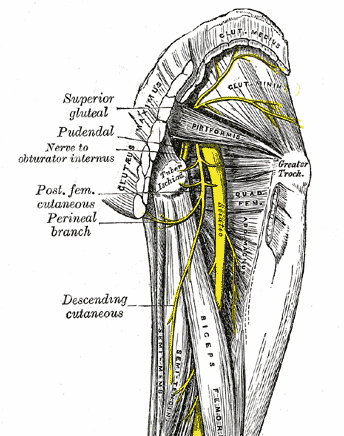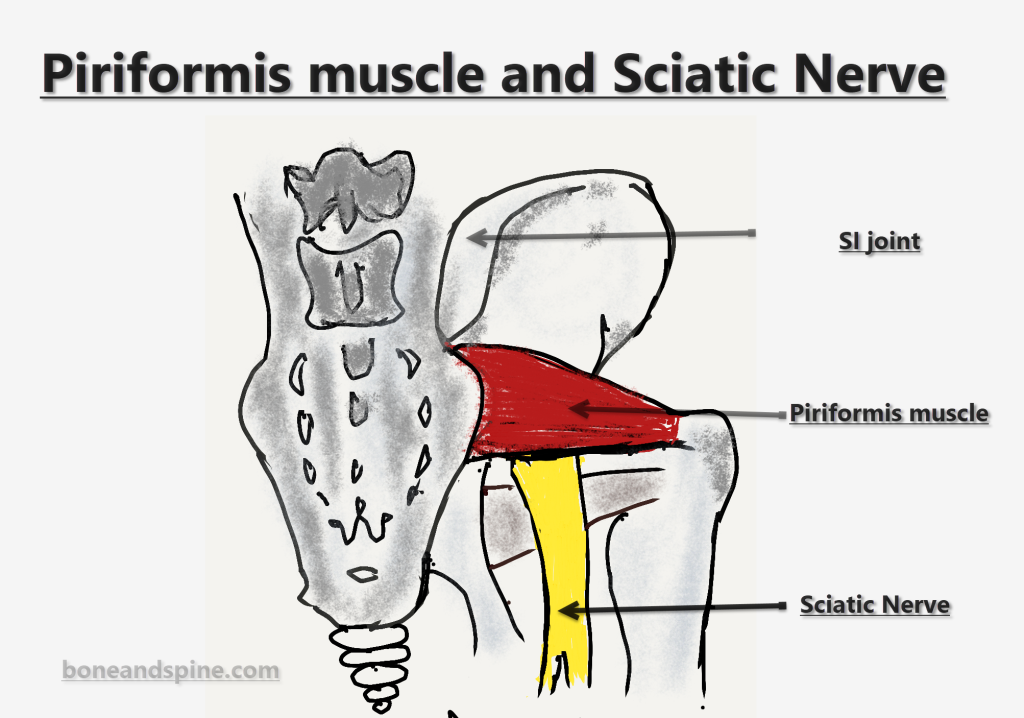Last Updated on November 22, 2022
Piriformis syndrome is radicular pain [commonly called sciatica] that occurs due to sciatic nerve entrapment caused by the piriformis muscle. The sciatic nerve is compressed or irritated by the piriformis muscle.
The symptoms are pain, tingling, and numbness in the buttocks and along the path of the sciatic nerve descending down the lower thigh and into the leg.
The syndrome may occur due to anatomical variations in the muscle-nerve relationship, or from overuse or strain.
Piriformis syndrome should be considered as a possible diagnosis when sciatica occurs without a clear spinal cause.
Piriformis syndrome has been reported to be responsible for up to 6% of all cases of low back pain and/or sciatica.
Relevant Anatomy
The piriformis is flat, oblique, and pyramidal-shaped muscle.
This muscle originates
- Anterior to the S2 to S4 vertebrae
- Superior margin of the greater sciatic foramen
- Sacrotuberous ligament
The muscle passes through the greater sciatic notch and then inserts on the greater trochanter of the femur.
The piriformis acts as an external rotator of the hip when the hip is extended. It acts as an adductor when the hip is flexion.
The muscle is supplied by L5, S1, and S2 roots via the nerve to the piriformis a branch of the sacral plexus.
Sciatic nerve runs vertically directly beneath the piriformis muscle. In some people, about 15-30% of the population, the nerve runs through the substance of the muscle.
Pathophysiology of Piriformis Syndrome
The basic event is compression or irritation of the sciatic nerve. Thus piriformis syndrome is a kind of entrapment neuropathy. In a few cases, this compression involves the pudendal nerve.
We read that the sciatic nerve is underneath the piriformis muscle. But in 15-30% of the population, the sciatic nerve passes through the substance of the piriformis muscle. These people have a greater incidence of piriformis syndrome than the general population.
Piriformis syndrome is found to be associated with following
- Rowing/sculling and bicycling. [activities that are performed during sitting and involve strenuous use of legs.
- Running
- Weak hip abductors/gluteus medius muscles and tight adductor muscles
- can cause the piriformis muscle to shorten and severely contract
- Stiffness of the sacroiliac joints
- Overpronation of the foot
Piriformis syndrome is also known as wallet sciatica or fat wallet syndrome, as the condition can be caused or aggravated by sitting with a large wallet in the affected side’s rear pocket.
The following causes may be responsible for Piriformis syndrome
The exact causes of piriformis syndrome are unknown. Suspected causes include:
- Muscle spasm in the piriformis muscle due to
- pathology in the muscle itself
- Pathology in neighboring structures like the sacroiliac joint or hip
- Injury of piriformis causing swelling
- Bleeding in the area of the piriformis muscle
Presentation
The patient presents with symptoms of sciatic radiculopathy. The symptoms include
- Radiating pain in
- buttock
- posterior thigh
- lower leg
- The pain is exacerbated with activity, prolonged sitting or walking.
- Pain when getting off the bed
- Unable to sit for prolonged periods
There may be a history of
- Increased activity like climbing stairs, long-distance walking running
- Injury to the region
- Lifting something improperly and damaging the piriformis muscle.
- Prolonged sitting
- Lack of physical activity.
A physical examination would reveal tenderness in the area of the sciatic notch.
Because the symptoms overlap with other causes of sciatica, the diagnosis is largely clinical and is one of exclusion. Other causes of sciatica need to be ruled out.
Special Tests
Special tests include stretching maneuvers to irritate the piriformis muscle.These stretches include:
Freiberg Test
Forceful internal rotation of the extended thigh produces the symptoms.
Pace Test
The Pace test is a good indicator of Piriformis Syndrome. The maneuver is done by resisted abduction and external rotation of the hip in a flexed position.
The test can be done with the patient sitting on the table with legs hanging. The patient is asked to abduct the hip while at the same time examiner resists that.
Reproduction of the symptoms makes the test positive.
Beatty Test
FAIR (flexion, adduction, internal rotation) Maneuver
The test can be performed with the patient supine or seated. The knee and hip flexed, and the hip medially rotated and adducted.A buttock pain or posterior thigh pain means a positive test.
Furthermore, manual pressure around the sciatic nerve may help reproduce the symptoms.
Sciatic Nerve Deep Palpation
May produce the pain
Differential Diagnoses
- Injury to the hamstring muscle
- Back sprain
- Discogenic pain
- Lumbosacral facet syndrome
- Spondylolisthesis
- Sacroiliac joint dysfunction or injury
Imaging
X-ray
X-rays may be absolutely normal or may show sacroiliac arthritis if present.
CT
CT is not particularly helpful in this syndrome but may reveal bony pathologies in a better way.
MRI
MRI can show the presence of irritation of the sciatic nerve at the level of the sciatic notch where the nerve passes under the piriformis muscle.
It can reveal anatomy and the relation of sciatic nerve better.
Treatment of Piriformis Syndrome
The treatment of Piriformis syndrome depends on the severity of the symptoms and varies from individual to individual.
The management of Piriformis syndrome may include a combination of the following treatment options.
Rest
Short-term rest can be very helpful. A rest period of 24 to 48 hours generally is enough.
Ice Therapy
Ice compression or massage alleviates pain for some time. It can be applied when the pain starts.
Take care not to apply the ice directly on the skin.
If there are activities that cause an increase in pain, it is a good idea to apply ice immediately after the activity.
Heat Therapy
Ice compressions work by reducing circulation and are very effective in activity-related pain. Heat therapy works by increasing circulation and taking away pain-causing mediators.
Heat therapy particularly works well in chronic pains. It should not be applied in pain after activities.
Medications
- Analgesics
- NASAIDs like ibuprofen, naproxen etc
- Opiod analgesics
- Muscle relaxants
- Drugs for neural pain like pregablin, gabapentin
Piriformis Steroids
Steroid injections and botulinum injections are considered in severe cases. Steroids work by reducing inflammation. Botulinum works by weakening the muscle.
The purpose of the injection is to decrease the immediate pain so as to enable the patient to participate in physical therapy.
Both injections help to relieve the pressure off the sciatic nerve.
Electrical Stimulation
This is done either with a transcutaneous electrical nerve stimulation (TENS) unit or an interferential current stimulator (IFC).
These can help to reduce pain and decrease muscle spasms.
Surgical Release
This is rarely needed. The piriformis muscle can be cut to relieve symptoms in extremely persistent cases.
Stretch Exercises
- Piriformis muscle stretches
- Hamstring stretches
Deep Massage
Deep massage increases the blood flow to the area and decreases muscle spasm.
Other Measures
- Custom foot orthotics
- Gait correction
References
- Huang ZF, Yang DS, Shi ZJ, Xiao J. [Pathogenesis of piriformis syndrome: a magnetic resonance imaging-based comparison study]. Zhonghua Yi Xue Za Zhi. 2018 Jan 02;98(1):42-45.
- Hopayian K, Danielyan A. Four symptoms define the piriformis syndrome: an updated systematic review of its clinical features. Eur J Orthop Surg Traumatol. 2018 Feb;28(2):155-164.
- Cass SP. Piriformis syndrome: a cause of nondiscogenic sciatica. Curr Sports Med Rep. 2015 Jan;14(1):41-4.
